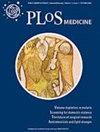在患有慢性非癌症疼痛的美国老年医疗保险受益人中,处方加巴喷丁类药物与阿片类药物的同时使用和跌倒相关损伤的风险:一项基于人群的队列研究
IF 9.9
1区 医学
Q1 MEDICINE, GENERAL & INTERNAL
引用次数: 3
摘要
背景加巴喷丁类药物越来越多地被用于治疗老年人的慢性非癌症疼痛(CNCP)。当与阿片类药物同时使用时,加巴喷丁类药物可能会增强中枢神经系统(CNS)抑郁,并增加跌倒风险。我们的目的是调查在患有CNCP的老年人中,与单独使用阿片类药物相比,加巴喷丁类药物与阿片类化合物同时使用是否与跌倒相关损伤的风险增加有关。方法和发现我们在2011年至2018年间对美国5%的联邦医疗保险受益人进行了一项基于人群的队列研究。研究样本包括年龄≥65岁、诊断为CNCP并开始使用阿片类药物的服务费(FFS)受益人。我们确定了加巴喷丁类药物和阿片类药物供应重叠≥1天的并发用户,并将并发的第一天指定为索引日期。我们根据同时使用加巴喷丁的使用者是在阿片类药物开始使用当天(队列1)还是在阿片组药物开始使用后(队列2)创建了2个队列。使用风险集抽样,在阿片类药物起始日期和索引日期,每个并发使用者与多达4名仅阿片类物质使用者匹配。我们从指标日期到使用经验证的基于索赔的算法确定的首次跌倒相关损伤事件、治疗中断或转换、死亡、医疗保险取消、住院或疗养院入院或研究结束(以先发生者为准)对患者进行了跟踪。在每个队列中,我们使用倾向评分(PS)加权Cox模型来估计跌倒相关损伤的95%置信区间(CI)的调整后危险比(aHR),并根据指数日期的年份、社会人口统计、慢性疼痛类型、合并症、虚弱、多药治疗、医疗保健利用率、非阿片类药物的使用以及指数日期当天和之前的阿片类药使用进行调整。我们在队列1中确定了6733名并发使用者和27092名匹配的仅阿片类药物使用者,在队列2中确定了5709名并发使用者,22388名匹配的纯阿片类物质使用者。队列1中跌倒相关损伤的发生率在随访期间为24.5/100人年(中位数为9天;四分位间距[IQR]为5-18天),队列2中随访期间为18.0/100人年。同时用药者与队列1中仅使用阿片类药物的使用者有相似的跌倒相关损伤风险(aHR=0.97,95%CI 0.71至1.34,p=0.874),但与队列2中仅使用阿片类药物者相比,其跌倒相关损伤的风险更高(aHR=1.69,95%CI 1.17至2.44,p=0.005),潜在的错误分类,以及医疗保险FFS计划承保的老年人之外的有限可推广性。结论在患有CNCP的老年医疗保险受益人的样本中,与仅启动阿片类药物相比,同时启动加巴喷丁类药物和阿片类物质与跌倒相关损伤的风险没有显著相关性。然而,在现有的阿片类药物方案中添加加巴喷丁类药物会增加跌倒风险。观察到的过度风险的机制,无论是药理学的还是由于联合治疗对高危患者的引导,都需要进一步研究。临床医生在同时开加巴喷丁类药物和阿片类药物处方时,应考虑联合治疗的风险和益处。本文章由计算机程序翻译,如有差异,请以英文原文为准。
Concurrent use of prescription gabapentinoids with opioids and risk for fall-related injury among older US Medicare beneficiaries with chronic noncancer pain: A population-based cohort study
Background Gabapentinoids are increasingly prescribed to manage chronic noncancer pain (CNCP) in older adults. When used concurrently with opioids, gabapentinoids may potentiate central nervous system (CNS) depression and increase the risks for fall. We aimed to investigate whether concurrent use of gabapentinoids with opioids compared with use of opioids alone is associated with an increased risk of fall-related injury among older adults with CNCP. Methods and findings We conducted a population-based cohort study using a 5% national sample of Medicare beneficiaries in the United States between 2011 and 2018. Study sample consisted of fee-for-service (FFS) beneficiaries aged ≥65 years with CNCP diagnosis who initiated opioids. We identified concurrent users with gabapentinoids and opioids days’ supply overlapping for ≥1 day and designated first day of concurrency as the index date. We created 2 cohorts based on whether concurrent users initiated gabapentinoids on the day of opioid initiation (Cohort 1) or after opioid initiation (Cohort 2). Each concurrent user was matched to up to 4 opioid-only users on opioid initiation date and index date using risk set sampling. We followed patients from index date to first fall-related injury event ascertained using a validated claims-based algorithm, treatment discontinuation or switching, death, Medicare disenrollment, hospitalization or nursing home admission, or end of study, whichever occurred first. In each cohort, we used propensity score (PS) weighted Cox models to estimate the adjusted hazard ratios (aHRs) with 95% confidence intervals (CIs) of fall-related injury, adjusting for year of the index date, sociodemographics, types of chronic pain, comorbidities, frailty, polypharmacy, healthcare utilization, use of nonopioid medications, and opioid use on and before the index date. We identified 6,733 concurrent users and 27,092 matched opioid-only users in Cohort 1 and 5,709 concurrent users and 22,388 matched opioid-only users in Cohort 2. The incidence rate of fall-related injury was 24.5 per 100 person-years during follow-up (median, 9 days; interquartile range [IQR], 5 to 18 days) in Cohort 1 and was 18.0 per 100 person-years during follow-up (median, 9 days; IQR, 4 to 22 days) in Cohort 2. Concurrent users had similar risk of fall-related injury as opioid-only users in Cohort 1(aHR = 0.97, 95% CI 0.71 to 1.34, p = 0.874), but had higher risk for fall-related injury than opioid-only users in Cohort 2 (aHR = 1.69, 95% CI 1.17 to 2.44, p = 0.005). Limitations of this study included confounding due to unmeasured factors, unavailable information on gabapentinoids’ indication, potential misclassification, and limited generalizability beyond older adults insured by Medicare FFS program. Conclusions In this sample of older Medicare beneficiaries with CNCP, initiating gabapentinoids and opioids simultaneously compared with initiating opioids only was not significantly associated with risk for fall-related injury. However, addition of gabapentinoids to an existing opioid regimen was associated with increased risks for fall. Mechanisms for the observed excess risk, whether pharmacological or because of channeling of combination therapy to high-risk patients, require further investigation. Clinicians should consider the risk–benefit of combination therapy when prescribing gabapentinoids concurrently with opioids.
求助全文
通过发布文献求助,成功后即可免费获取论文全文。
去求助
来源期刊

PLoS Medicine
医学-医学:内科
CiteScore
21.60
自引率
0.60%
发文量
227
审稿时长
3 months
期刊介绍:
PLOS Medicine aims to be a leading platform for research and analysis on the global health challenges faced by humanity. The journal covers a wide range of topics, including biomedicine, the environment, society, and politics, that affect the well-being of individuals worldwide. It particularly highlights studies that contribute to clinical practice, health policy, or our understanding of disease mechanisms, with the ultimate goal of improving health outcomes in diverse settings.
Unwavering in its commitment to ethical standards, PLOS Medicine ensures integrity in medical publishing. This includes actively managing and transparently disclosing any conflicts of interest during the reporting, peer review, and publication processes. The journal promotes transparency by providing visibility into the review and publication procedures. It also encourages data sharing and the reuse of published work. Author rights are upheld, allowing them to retain copyright. Furthermore, PLOS Medicine strongly supports Open Access publishing, making research articles freely available to all without restrictions, facilitating widespread dissemination of knowledge. The journal does not endorse drug or medical device advertising and refrains from exclusive sales of reprints to avoid conflicts of interest.
 求助内容:
求助内容: 应助结果提醒方式:
应助结果提醒方式:


